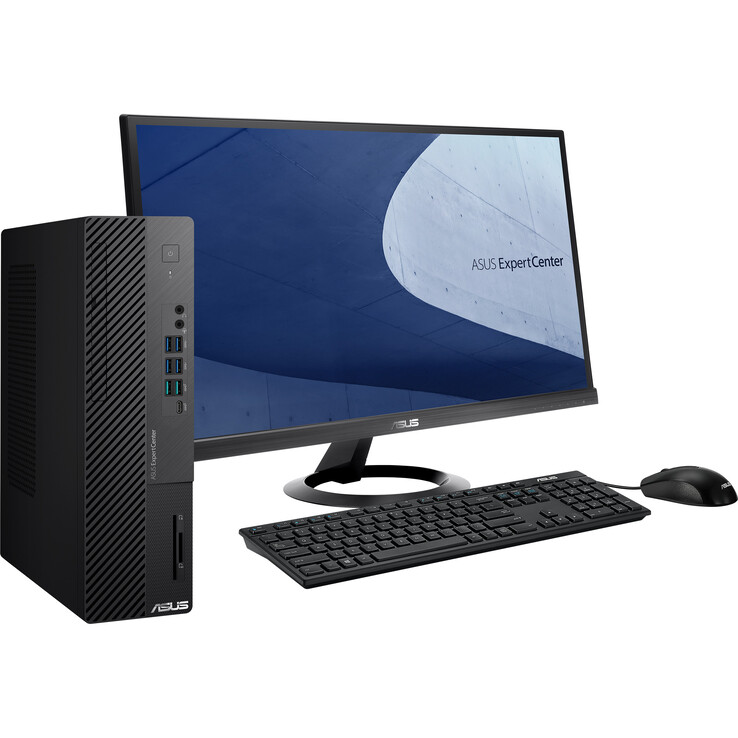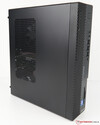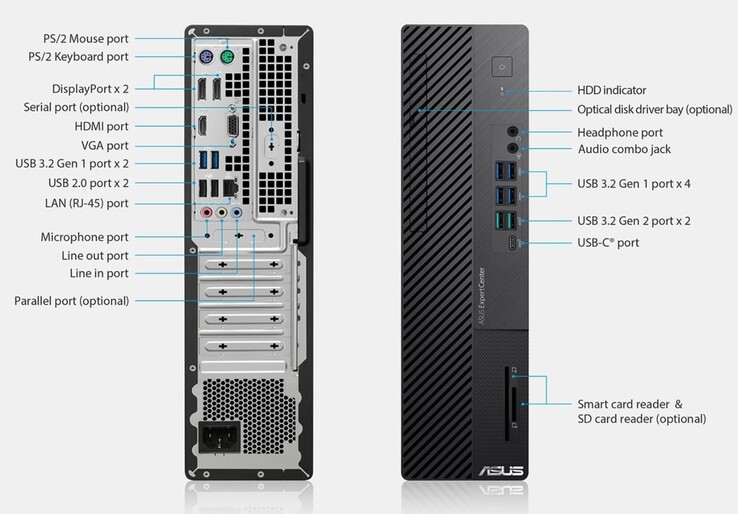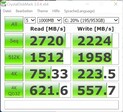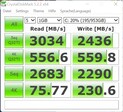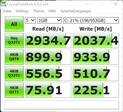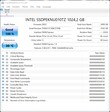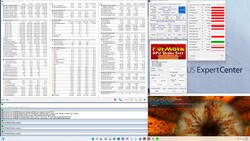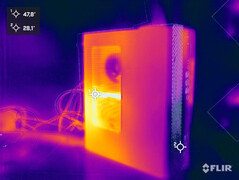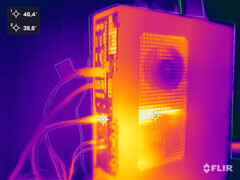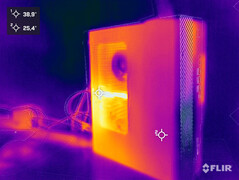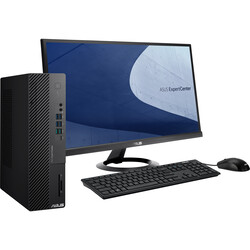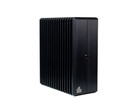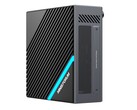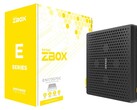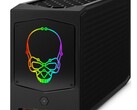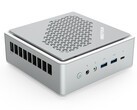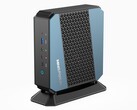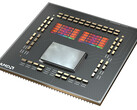Asus ExpertCenter D9 SFF D900SC review: A compact office PC for professional use
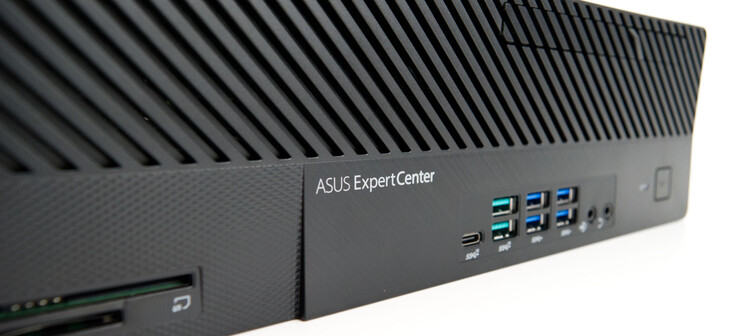
Asus is more familiar to most users as a hardware manufacturer or as a laptop manufacturer. However, Asus has also been present for a long time in the area of desktop PCs. With the ExpertCenter series, the system manufacturer offers powerful office PCs with current hardware.
Based on the Intel Core i7-11700, with the Rocket Lake CPU, there is a modern octa-core processor that is also relatively efficient at the same time. The 32 GB of working memory will also allow you to run storage intensive applications without any trouble, such as virtual machines, for example. In addition, our test unit includes a professional graphics card with the Nvidia T600, which transforms the system into a compact workstation. In this way, the system as configured in our test covers a very wide range of usage scenarios, overall.
The Asus ExpertCenter D9 SFF in Detail
Case
The case and particularly also the internal construction remind us strongly of a typical industrial PC, which isn't necessarily meant as a negative. The construction is well thought-out and functional, and that is what matters. All the components can be replaced and expanded quickly and without any problems. However, you should note that expansion cards can only be installed in the low-profile format. This will naturally also limit the use of dedicated graphics cards significantly.
The selection of materials is dominated by aluminum and plastic. The latter is used mainly in front. We did not find any sharp edges that could lead to injuries, and the workmanship is at a very good level. At almost 5 kg (~11 lb), the office PC is not excessively heavy.
Equipment
The base is an Asus mainboard with a Q570 chipset. With this, the Asus ExpertCenter D9 SFF D900SC offers numerous USB connections. Six USB Type-A ports in front and four in the back are more than sufficient. We also find HDMI, DisplayPort, and VGA connections in the back. However, those only use the iGPU of the Intel Core i7-11700. In addition, the Nvidia T600 brings four Mini DisplayPort connections. Our test unit also offers a serial port, further expanding the usage scenarios for the PC.
Another sensitive addition is the card reader next to the SD card reader, which is an appreciated feature in the business segment.
Communication
The WiFi module of the Asus ExpertCenter D9 SFF D900SC offers WiFi 6, which is the newest standard for the fastest data transfer. However, in our comparison, the performance is only sufficient for the good middle of the test field. But there is also a RJ45 connection, and transfer rates of up to 1 Gbit/s are possible here.
SD Card Reader
To mention the positive aspect first, there is an SD card reader. However, in terms of performance, it only offers USB 2.0 speeds. This unfortunately makes fast data transfers impossible. In the best case, our UHS-II storage card (AV Pro SD microSD 128 GB V60) is read at only about 20 MB/s, and when writing, the transfer rates aren't any better either.
| SD Card Reader | |
| average JPG Copy Test (av. of 3 runs) | |
| Zotac ZBOX Magnus EN173070C (AV Pro SD microSD 128 GB V60) | |
| Asus ExpertCenter D9 SFF (AV Pro SD microSD 128 GB V60) | |
| maximum AS SSD Seq Read Test (1GB) | |
| Zotac ZBOX Magnus EN173070C (AV Pro SD microSD 128 GB V60) | |
| Asus ExpertCenter D9 SFF (AV Pro SD microSD 128 GB V60) | |
Performance
Processor
In terms of the processor, Asus currently uses an Intel Core i7-11700 of the Rocket Lake S series. The processor offers 8 cores and 16 threads at a basic clock speed of 2.5 GHz. However, most of the time, this is exceeded, and in Turbo up to 4.9 GHz are possible. The power consumption is 190 watts in our model, which is the PL1 as well as the PL2 value. With this, the full performance of the processor is always available. However, in practice the cooling also needs to ensure that there are no limitations here as well.
Our test comparison shows that the Intel Core i7-11700 produces approximately the performance of an Intel Core i5-11600K. The Intel Core i7-10700 is about 10% slower. Compared to the current Alder Lake S generation, the Core i7-11700 has to be content with a disadvantage of about 17% to the Intel Core i5-12600K. Despite of this, the Intel Core i7-11700 is still a fast processor that is also suited for computing-intensive applications.
You can find additional benchmarks on the processors here.
* ... smaller is better
AIDA64: FP32 Ray-Trace | FPU Julia | CPU SHA3 | CPU Queen | FPU SinJulia | FPU Mandel | CPU AES | CPU ZLib | FP64 Ray-Trace | CPU PhotoWorxx
| Performance rating | |
| Average of class Desktop | |
| AMD Ryzen 7 5700G | |
| Minisforum EliteMini HX90 | |
| AMD Ryzen 7 5800X | |
| Morefine S500+ | |
| Minisforum EliteMini B550 | |
| Zotac ZBOX Magnus EN173070C | |
| Asus ExpertCenter D9 SFF | |
| Average Intel Core i7-11700 | |
| Intel Core i5-12600K | |
| AMD Ryzen 5 5600X | |
| AIDA64 / FP32 Ray-Trace | |
| Average of class Desktop (12248 - 84577, n=16, last 2 years) | |
| AMD Ryzen 7 5800X | |
| Minisforum EliteMini HX90 | |
| AMD Ryzen 7 5700G | |
| Minisforum EliteMini B550 | |
| Morefine S500+ | |
| Zotac ZBOX Magnus EN173070C | |
| AMD Ryzen 5 5600X | |
| Asus ExpertCenter D9 SFF | |
| Average Intel Core i7-11700 (n=1) | |
| Intel Core i5-12600K | |
| AIDA64 / FPU Julia | |
| Average of class Desktop (65152 - 246125, n=16, last 2 years) | |
| AMD Ryzen 7 5700G | |
| Minisforum EliteMini HX90 | |
| Minisforum EliteMini B550 | |
| Morefine S500+ | |
| AMD Ryzen 7 5800X | |
| AMD Ryzen 5 5600X | |
| Zotac ZBOX Magnus EN173070C | |
| Asus ExpertCenter D9 SFF | |
| Average Intel Core i7-11700 (n=1) | |
| Intel Core i5-12600K | |
| AIDA64 / CPU SHA3 | |
| Average of class Desktop (2982 - 10804, n=16, last 2 years) | |
| Zotac ZBOX Magnus EN173070C | |
| AMD Ryzen 7 5700G | |
| Asus ExpertCenter D9 SFF | |
| Average Intel Core i7-11700 (n=1) | |
| Minisforum EliteMini HX90 | |
| Intel Core i5-12600K | |
| Minisforum EliteMini B550 | |
| Morefine S500+ | |
| AMD Ryzen 7 5800X | |
| AMD Ryzen 5 5600X | |
| AIDA64 / CPU Queen | |
| Average of class Desktop (76512 - 187912, n=16, last 2 years) | |
| AMD Ryzen 7 5800X | |
| AMD Ryzen 7 5700G | |
| Minisforum EliteMini HX90 | |
| Minisforum EliteMini B550 | |
| Asus ExpertCenter D9 SFF | |
| Average Intel Core i7-11700 (n=1) | |
| Morefine S500+ | |
| Zotac ZBOX Magnus EN173070C | |
| Intel Core i5-12600K | |
| AMD Ryzen 5 5600X | |
| AIDA64 / FPU SinJulia | |
| Average of class Desktop (6443 - 35251, n=16, last 2 years) | |
| AMD Ryzen 7 5800X | |
| AMD Ryzen 7 5700G | |
| Minisforum EliteMini HX90 | |
| Minisforum EliteMini B550 | |
| Morefine S500+ | |
| AMD Ryzen 5 5600X | |
| Intel Core i5-12600K | |
| Zotac ZBOX Magnus EN173070C | |
| Asus ExpertCenter D9 SFF | |
| Average Intel Core i7-11700 (n=1) | |
| AIDA64 / FPU Mandel | |
| Average of class Desktop (31697 - 129745, n=16, last 2 years) | |
| AMD Ryzen 7 5700G | |
| Minisforum EliteMini HX90 | |
| Minisforum EliteMini B550 | |
| Morefine S500+ | |
| AMD Ryzen 7 5800X | |
| AMD Ryzen 5 5600X | |
| Zotac ZBOX Magnus EN173070C | |
| Asus ExpertCenter D9 SFF | |
| Average Intel Core i7-11700 (n=1) | |
| Intel Core i5-12600K | |
| AIDA64 / CPU AES | |
| Average of class Desktop (57777 - 513073, n=16, last 2 years) | |
| AMD Ryzen 7 5700G | |
| Minisforum EliteMini HX90 | |
| Zotac ZBOX Magnus EN173070C | |
| Asus ExpertCenter D9 SFF | |
| Average Intel Core i7-11700 (n=1) | |
| Minisforum EliteMini B550 | |
| Morefine S500+ | |
| AMD Ryzen 7 5800X | |
| AMD Ryzen 5 5600X | |
| Intel Core i5-12600K | |
| AIDA64 / CPU ZLib | |
| Average of class Desktop (887 - 2674, n=16, last 2 years) | |
| Intel Core i5-12600K | |
| AMD Ryzen 7 5800X | |
| Minisforum EliteMini HX90 | |
| AMD Ryzen 7 5700G | |
| Minisforum EliteMini B550 | |
| Morefine S500+ | |
| Zotac ZBOX Magnus EN173070C | |
| AMD Ryzen 5 5600X | |
| Asus ExpertCenter D9 SFF | |
| Average Intel Core i7-11700 (n=1) | |
| AIDA64 / FP64 Ray-Trace | |
| Average of class Desktop (6471 - 44013, n=16, last 2 years) | |
| AMD Ryzen 7 5800X | |
| Minisforum EliteMini HX90 | |
| AMD Ryzen 7 5700G | |
| Morefine S500+ | |
| Minisforum EliteMini B550 | |
| Zotac ZBOX Magnus EN173070C | |
| AMD Ryzen 5 5600X | |
| Asus ExpertCenter D9 SFF | |
| Average Intel Core i7-11700 (n=1) | |
| Intel Core i5-12600K | |
| AIDA64 / CPU PhotoWorxx | |
| Intel Core i5-12600K | |
| Average of class Desktop (33304 - 55966, n=16, last 2 years) | |
| AMD Ryzen 7 5700G | |
| Asus ExpertCenter D9 SFF | |
| Average Intel Core i7-11700 (n=1) | |
| AMD Ryzen 7 5800X | |
| AMD Ryzen 5 5600X | |
| Zotac ZBOX Magnus EN173070C | |
| Morefine S500+ | |
| Minisforum EliteMini HX90 | |
| Minisforum EliteMini B550 | |
AIDA64: FP32 Ray-Trace | FPU Julia | CPU SHA3 | CPU Queen | FPU SinJulia | FPU Mandel | CPU AES | CPU ZLib | FP64 Ray-Trace | CPU PhotoWorxx
The Asus ExpertCenter D9 SFF in the Cinebench R15 Multi Loop
The behavior of the Intel Core i7-11700 in the Asus ExpertCenter D9 SFF D900SC is similar to the processors in the two Intel NUC comparison devices and the Zotac ZBOX Magnus. The result of the initial run will not be achieved in further runs anymore, which means that the Asus is unable to keep the performance of the processor constant. On the other hand, the performance across the 50 runs of the Cinebench-R15 constant loop remains stable to a large extent, so that you don't have to expect any additional performance drops.
Application Performance and Storage Solution
The subjective impression of the Asus ExpertCenter D9 SFF D900SC system performance is good. At the same time, our test unit also has some trouble to achieve good results at times in the measured values. For example, it is only sufficient for the next to last place in the PCMark score. On the other hand, the system is able to achieve relatively good results in the render tests due to the Nvidia T600. In order to emphasize the performance in this regard, we also included a system with the Nvidia GeForce GTX 1650 here. Both graphics cards are based on the same chip. The separate tests show clearly what is possible with better driver optimizations.
The subjective performance impression is also influenced significantly by the SSD that is used. The 1-TB M.2-2280 SSD from Intel offers fast read and write rates. We particularly want to point out the very good 4K read rate, which will increase the load speed of many small files considerably.
| DPC Latencies / LatencyMon - interrupt to process latency (max), Web, Youtube, Prime95 | |
| Minisforum EliteMini B550, AMD Ryzen 7 5700G | |
| Morefine S500+, AMD Ryzen 9 5900HX | |
| Asus ExpertCenter D9 SFF, Intel Core i7-11700 | |
| Zotac ZBOX Magnus EN173070C, Intel Core i7-11800H | |
| Minisforum EliteMini HX90, AMD Ryzen 9 5900HX | |
| AMD Ryzen 7 5700G, AMD Ryzen 7 5700G | |
| Prime Computer Primestation Pulsar, AMD Ryzen 7 PRO 5750G | |
* ... smaller is better
3D and Gaming Performance
The primary usage scenarios for the Asus ExpertCenter D9 SFF D900SC are office applications, image or video processing, and some smaller tasks in the workstation area. However, the small Nvidia T600 is still suited for one or the other game as well. But you have to accept some limitations in newer or more demanding games. Very storage-intensive games such as Far Cry 6 quickly bring the small graphics card to its knees. The 4 GB of GDDR6 VRAM already hits its limits in the High preset. Basically, the performance of the Nvidia T600 can be compared with that of the Nvidia GeForce GTX 1650. Both graphics cards are based on the TU117 graphics chip of the Turing generation. However, the TU117 of the Nvidia T600 is slightly limited, which is reflected in the number of shader units. The Nvidia T600 offers 640 active shaders, even though the GTX 1650 brings 896 active shaders. Only the Nvidia T1000 is able to keep up with the GeForce GTX 1650 completely, offering the same amount of shader units.
Those who want to equip the Asus ExpertCenter D9 SFF D900SC with a more powerful graphics card have to keep the compatibility in mind, since you can only insert a graphics card in the low-profile format.
You can find additional comparisons and benchmarks in our GPU comparison list.
| The Witcher 3 | |
| 1024x768 Low Graphics & Postprocessing | |
| Zotac ZBOX Magnus EN173070C | |
| Sapphire Pulse Radeon RX 6500 XT | |
| Asus ExpertCenter D9 SFF | |
| Minisforum EliteMini TH50 | |
| Morefine S500+ | |
| Prime Computer Primestation Pulsar | |
| Minisforum EliteMini HX90 | |
| Minisforum EliteMini B550 | |
| 1920x1080 High Graphics & Postprocessing (Nvidia HairWorks Off) | |
| Zotac ZBOX Magnus EN173070C | |
| Sapphire Pulse Radeon RX 6500 XT | |
| Asus ExpertCenter D9 SFF | |
| Minisforum EliteMini TH50 | |
| Prime Computer Primestation Pulsar | |
| Morefine S500+ | |
| Minisforum EliteMini HX90 | |
| Minisforum EliteMini B550 | |
| low | med. | high | ultra | QHD | 4K | |
|---|---|---|---|---|---|---|
| GTA V (2015) | 181.5 | 175.6 | 80.3 | 38.2 | 26.6 | 25 |
| The Witcher 3 (2015) | 139.1 | 82.8 | 47.5 | 27.2 | 16.1 | |
| Dota 2 Reborn (2015) | 162.8 | 148.6 | 120.7 | 110.5 | 39.6 | |
| Final Fantasy XV Benchmark (2018) | 70.7 | 34.9 | 25.1 | 17.8 | 9.98 | |
| X-Plane 11.11 (2018) | 132.8 | 107 | 95.9 | 40.8 | ||
| Far Cry 5 (2018) | 95 | 46 | 42 | 39 | 26 | 12 |
| Strange Brigade (2018) | 174.4 | 64.9 | 51.4 | 44.8 | 31.9 | 17.9 |
| Metro Exodus (2019) | 74.6 | 34 | 24 | 19.4 | 14.8 | 8.47 |
| Borderlands 3 (2019) | 107.6 | 42 | 26.7 | 19.9 | 13.4 | 5.54 |
| F1 2020 (2020) | 150.4 | 73.1 | 55.5 | 38.6 | 27 | 14.5 |
| F1 2021 (2021) | 171.9 | 78.8 | 63.7 | 40.2 | 29.1 | 15.7 |
| Far Cry 6 (2021) | 93.5 | 44.6 | 21.3 | 6.33 |
Emissions
Noise Emissions
The noise emissions of the Asus ExpertCenter D9 SFF D900SC remain within limits. While during idle operation, the device is hardly audible, under load, the noise level increases to 37.7 dB(A) on average. During the stress test, which simulates an extreme scenario, we measure a maximum of 43.1 dB(A). In addition, the fan noise cannot be described as annoying. The fan speed is changed slowly, which prevents fast revving.
Noise level
| Idle |
| 31.4 / 31.4 / 31.5 dB(A) |
| Load |
| 37.7 / 43.1 dB(A) |
 | ||
30 dB silent 40 dB(A) audible 50 dB(A) loud |
||
min: | ||
Temperatures
In our stress test, we run Prime95 and FurMark simultaneously, while documenting the temperatures in this extreme scenario. The Intel Core i7-11700 reaches 85 °C (185 °F) already after a short time, which isn't much of a problem. After that, the power consumption and temperature of the processor start dropping, with the latter finally leveling out at about 67 °C (153 °F) on average. In the Nvidia T600 we measure the highest GPU temperature at 86.6 °C (187.9 °F). At the same time, HWiNFO specifies a maximum of 98 °C (208 °F) as the GPU hotspot temperature, which also gives no reason for panicking.
In our stress test, the hotspot of the case was in the area of the Nvidia T600. However, the surface temperatures still remained significantly below the 50 °C (122 °F) mark.
Power Consumption
The Asus ExpertCenter D9 SFF D900SC shows itself to be pleasantly energy efficient during idle operation and under low load. The 300-Watt power supply delivers 120 watts on average, increasing up to 153 watts on average during the stress test. During some peak loads, it briefly reaches up to 240 watts, which doesn't pose any problem for the power supply.
| Off / Standby | |
| Idle | |
| Load |
|
Key:
min: | |
Power Consumption with External Monitor
Pros
Cons
Verdict - An office PC for many tasks
The Asus ExpertCenter D9 SFF D900SC is a fast office PC throughout, which can also serve as a compact workstation in our configuration. The Intel Core i7-11700 represents a good choice, showing in the test that it offers sufficient performance reserves. The visuals and construction are unremarkable, which is completely okay. For productivity, what matters more is the functionality, and that is definitely offered by the Asus ExpertCenter D9 SFF D900SC. For example, there are numerous USB ports, allowing you to connect many external devices at the same time. In addition, you can also expand the usage scenarios of the PC with the serial connection. As a business device, the Asus ExpertCenter D9 SFF D900SC also offers a number of security features such as Intel vPro or a smart card reader.
The Asus ExpertCenter D9 SFF is a versatile PC with workstation potential at a relatively low price.
In terms of pure performance, the ASUS ExpertCenter D9 SFF D900SC is a fast office PC. In the test, our test unit often placed in the good middle of our test field. However, we still have to say that there isn't much head space in terms of the pure performance. The 1200 socket platform has already been replaced with Alder Lake S last year, and with Raptor Lake S, the next CPU generation is already in the starting blocks. The ASUS ExpertCenter D9 SFF is also available in the D900SD version with Intel's 12th generation processor. However, we currently have no information on availability yet. Apropos availability, our test unit is also hard to find in this configuration. A slightly weaker model based on the Intel Core i5-11400 is available starting from 770 Euros (~$803) from Amazon in Germany (While a similar model is listed on the US Amazon site, it doesn't appear to be currently available). You have to expect about 1200 Euros (~$1251) for our test configuration (Another model using the same processor is listed at the US Amazon site for $971). Considering its versatility, this is a fair price, in our opinion. Those who are looking for alternatives since the Asus is hard to find can take a closer look at the Lenovo ThinkStation P350. The comparably equipped model costs about the same amount at Amazon and is directly available.




